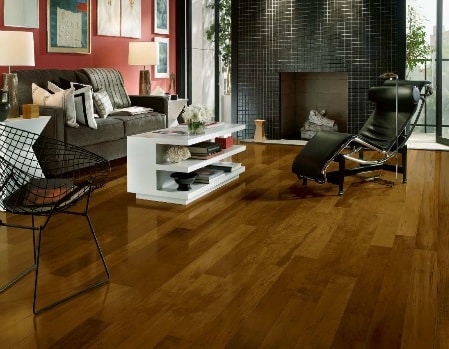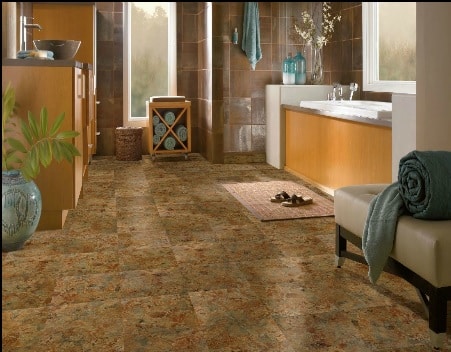
Manufacturers are now able to mimic more expensive-looking floors, keeping the cost low without hindering style and design. With hundreds of designs available you’ll be able to mimic the tile kitchen floor you’ve always wanted, or capture the appearance and warmth of hardwood without breaking the bank. There are many benefits to purchasing and installing vinyl flooring, and although it can look like hardwood, tile, concrete or any other flooring material, the product still has a few draw backs. Here are some advantages and disadvantages of choosing vinyl for your home renovation.
Pros of Vinyl Flooring
Vinyl flooring is one of the least expensive flooring options on the market. According to Homewyse.com, in 2014 it cost an average of $2.78-$4.62 per square foot for installed sheet vinyl flooring. This estimate came from average material costs, unit labour productivity rates and the national hourly average for labour wages. Super low range vinyl can cost as little as a dollar per foot, or less, while higher-end premium vinyl can cost up to $10 per square foot. The price difference is determined by the manufacturer, quality and design of the tile. To get a more accurate quote, contact a flooring store in Edmonton.
Vinyl flooring is incredibly durable and works well in high traffic areas, especially if you have pets and children. If it’s installed properly and cared for, it can easily last up to 20 years depending on the quality of the product you purchased. Solid vinyl is made with the colour or design in every layer of the material to prevent noticeable damage from scratches. If you install vinyl tiles, you can easily replace damaged tiles with new ones without having to rip up the entire floor.
Vinyl flooring’s durability makes it a good choice for commercial applications. Flooring store showrooms carry a huge selection of commercial vinyl products and can help you determine if you’ll need a more heavy-duty product.
Vinyl flooring is low maintenance and very easy to clean. Sweep away grit and dirt before mopping the floor with a generic surface cleaner. Stains are easily removed with a vinyl floor cleaner or even with bleach. It is also water resistant, which is why it’s a good choice for the kitchen, bathroom and laundry room.
As mentioned, vinyl flooring now comes in a wide range of design options. Colours, patterns, textures and designs are nearly endless. Mix and match solid and composite vinyl to create a unique pattern or choose a printed vinyl to recreate the look of natural stone, hardwood or any other flooring material. Vinyl allows you to get really creative with your flooring, at a fraction of the cost.

Cons of Vinyl Flooring
Although vinyl flooring is very durable, it doesn’t stand up well to heavy loads and can be easily damaged or gauged by sharp objects. If you choose a low-quality vinyl product it might be more susceptible to rips and tears. Unlike hardwood, vinyl cannot be refinished so if it’s damaged it needs to be replaced. If you are using sheet vinyl rather than tiles, the entire floor has to be removed and replaced. Cuts or gauges in a vinyl floor could also cause damage to your subflooring. If it traps dirt or grit between the flooring and your subflooring during installation, this grit can wear down the material over time eventually causing lumps, rips or tears to come through to the surface.
Vinyl flooring can also be damaged by extreme temperatures or too much direct sunlight. Patterns can fade or the entire floor can yellow with age. Sometimes dirt can get trapped between the wax layer of a vinyl floor causing it to discolour or the sun can cause it to change colour. High-quality vinyl is less susceptible to this kind of damage.
Manufacturing vinyl is not the most eco- friendly practice and this causes concern for many environmental conscience homeowners. Natural gas, petroleum, and other non-renewable resources are used during the manufacturing process. Plus, the chemicals used during manufacturing can cause an out-gassing after the floor is installed, potentially releasing toxic chemicals into the air of your home. Negative health effects could include respiratory issues, irritated eyes or inflamed asthma symptoms. The level of outgassing differs for each type of vinyl floor based on its chemical make-up.
To add to the environmental concern, vinyl flooring is not biodegradable and is rarely recycled. That means old ripped-out vinyl flooring will take years to break down, often piling up in landfills.
Installing Vinyl Flooring
Installing vinyl flooring is a home improvement project that is often tackled by avid do-it-yourselfers. Some manufacturers will even provide a do-it-yourself installation kit. The DIY Network has a step-by-step guide for installing your own vinyl flooring. Learn how to prepare the subfloor, cut, layout and attach the vinyl flooring along with tips for cleaning and maintenance. Read “How to Install Vinyl Flooring” to get an idea of what’s involved with this home renovation project.
For those who would rather consult with a professional flooring installer, head to RenovationFind.com for a full directory of accredited trusted flooring companies.









